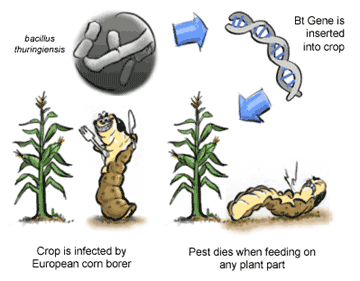
Western corn rootworm beetles feeding on a maize cob. Certain cultivars of Bt maize are resistant to this serious pest. GM rootworm resistant crops are not approved for cultivation in the European Union but are now being grown in the US.
"Pest Resistant Crops." Pest Resistant Crops. N.p., n.d. Web. 22 Oct. 2014.
Solution: The scientific solution to this problem is to use GMO crops such as Bt-corn.GMO (genetic modified organisms) is when scientist extract DNA for a different to type of species into another specie without sexual reproduction and they use genetic engineering in order to get the genetic traits they want such as more nutrition which can be more healthier and pesticide resistance which can be a major solution to safer crops and and this can be useful for farmers as crops are not so reliable for our food storage these days and that it can be protected from pest such as insects and weeds. For example During the process of Bt-corn which is a type of GMO they used Bt Delta Endotoxin which can kill insects when they eat it making them a much less complicated problem and it is safe for humans to eat.

The process of how Bt-corn is used
"SCQ." SCQ. N.p., n.d. Web. 22 Oct. 2014.
Benefits: Crop losses are frustrating as farmers loss income and can lead to starvation in developing countries and so farmers have to use chemicals and pesticides in order for their crops to be safe but consumers don't want to eat that so GMO foods such as Bt-corn can be a benefit to farmers as they are pesticide resistance and cheaper to put in the market. Gmos can also offer nutrition such as golden rice which contains a lot of vitamin A because today third world countries cannot get so much nutrition for their health when they eat food such as rice so scientist are creating and adding more nutrition to GMO crops so it has a solution to prevent blindness in third world countries.

The green bar represents the normal rice nutrition while the orange bar represents the golden rice nutrition.
"Golden Rice Project." Vitamin A Deficiency. N.p., n.d. Web. 25 Oct. 2014.
Limitations: Even though GMOs have the potential to improve and change the world their are many problems involving GMO such as allergies when Brazil put nut protein in a genetic engineered soya been it was allergic to Adults and children especially life threatening allergies which can be a serious problem to human health. GMo crops which are pesticide and herbicide resistant can create super bugs which are pesticide resistant can cause serious problems such as crop production and which would be harder to control.

A child who has a peanut allergic reaction

A child who has a peanut allergic reaction
"Peanut Allergy on the Rise: Clever Cure on the Horizon." Wondergressive. N.p., n.d. Web. 25 Oct. 2014.
Factors That Are Affected From The Solution:
One of the factors which is stopping the development of GMO is that farmers in third world countries are having a hard time buying new and expensive seeds every year for their crops form companies which can lead to farmers thinking that GMOs are not reliable to them so they will convince people to not buy it and not use and people are afraid that companies will raise the price so high for GMO crops that farmers and third world countries would not be able to afford it. Another factor which is also stopping the development of GMO is that GMOs can cause unknown effects on human health because scientist extract different genes of a species into a another species which can lead to unexpected and negative effects like in a recent article published in Lancet observed the effects on the digestive system on rats and the study claimed that there were appreciable differences in the intestines of rats fed GM potatoes and rats fed unmodified potatoes but people say that it is still imperfect and not safe to try and not reliable.
Sources:1. "Pest Resistant Crops." Pest Resistant Crops. N.p., n.d. Web. 22 Oct. 2014.
2. "What Are the Harmful Effects of Insects?" EHow. Demand Media, 28 June 2011. Web. 25 Oct. 2014.
3. "Genetically Modified Foods: Harmful or Helpful?" Genetically Modified Foods: Harmful or Helpful? N.p., n.d. Web. 23 Oct. 2014.
4. "Ten Disadvantages of Genetically Modified Food." HubPages. N.p., n.d. Web. 23 Oct. 2014.